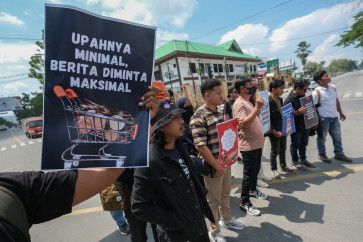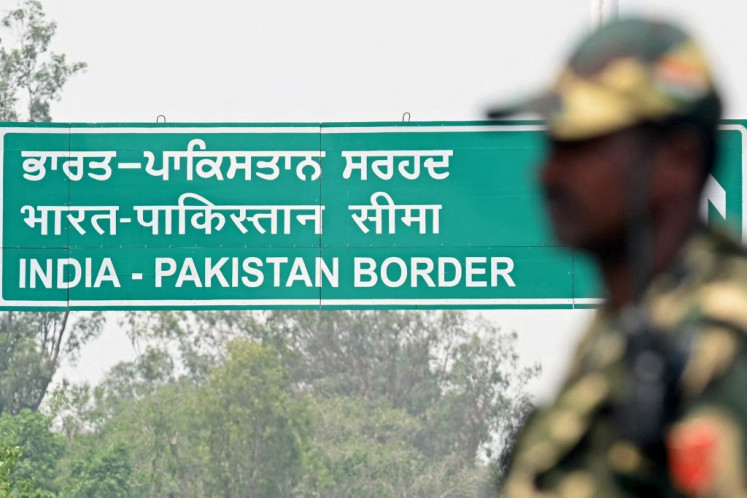Priorities for disaster risk reduction
Southeast Asia is a global disaster hot spot
Change text size
Gift Premium Articles
to Anyone

S
outheast Asia is a global disaster hot spot. More than 50 percent of global disaster mortalities occurred in the region during the period of 2004 to 2014.
Over the last two decades, global disaster risk governance mechanisms have been considered effective in regulating disaster risk at international and national levels. For instance, the Hyogo Framework for Action (HFA) for Disaster Risk Reduction (DRR) 2005-2015, with the vision of building countries' and communities' resilience to disasters, has encouraged countries in the developing world to gradually shift from reactive to anticipatory disaster risk management.
The Sendai Framework for Disaster Risk Reduction 2015-2030 ' the predecessor of the HFA ' is built on the facts that continuity in risk reduction cannot be adequately implemented by the member states, because other stakeholders such as NGOs, academia and private sectors are needed to play active roles. The framework was adopted by member states at the Third UN World Conference on DRR in Sendai, Japan, on March 18.
The question is how a global DRR framework should be adopted by regional actors. What does it mean for ASEAN with its ASEAN Agreement for Disaster Management and Emergency Response? What does Sendai's framework mean for Southeast Asia's 600 million people?
From 2004 to 2014, Southeast Asia contributed to more than 50 percent of the total global disaster fatalities, or 354,000 of the 700,000 deaths in disasters worldwide. The total economic loss was US$91 billion.
About 191 million people were displaced temporarily and disasters affected an additional 193 million people. In short, about one in three to four people in the region experienced different types of losses. There was an increase in the rate of disaster mortality from eight (during 1990 to 2003) to 61 deaths per 100,000 people (during 2004 to 2014).
Impacts of disasters disproportionately affect the poor and vulnerable. If ASEAN could not reduce disaster risks in its regional boundary, the Sendai Framework for DRR will unlikely achieve its target by 2030.
The Sendai Framework aims to 'substantially increase the number of countries with national and local disaster risk reduction strategies by 2020'. Member states are required to develop new DRR strategies by 2020 with more ambitious targets: To reduce global disaster mortality by 2030, by lowering the average of 100,000 global fatalities between 2020 and 2030 compared to 2005 to 2015 as a baseline.
The targets of the framework further include reducing the number of affected people globally (measured by an average per 100,000) between 2020 and 2030 compared to 2005 to 2015, reducing disaster damage to critical infrastructure and disruption of basic services and 'substantially increase the availability of and access to multi-hazard early warning systems and disaster risk information and assessments to the people by 2030'.
The Sendai Framework provides the guiding principles that suggest that each state can ensure 'the primary responsibility to prevent and reduce disaster risk' in four priorities for action:
First, understanding risk at the national level that includes promotion of data collection, risk analysis, regular updates, capacity building, promotion of investment and innovation in risk reduction and dissemination of disaster risk information;
Second, strengthening disaster risk governance to manage disaster risk, among others by integrating DRR in various sectors, from agriculture to infrastructure at different levels, entailing the empowerment of local authorities, coordination with civil societies and addressing root causes of disaster risks;
Third, investing in risk reduction for resilience by creating, for instance, promotion of public and private mechanisms for risk transfer and insurance, risk sharing and protection;
Fourth, enhance disaster preparedness for effective response and 'to build back better' in recovery, rehabilitation and reconstruction.
The question is, what should ASEAN prioritize in the next five years? At the moment, there is no regional target on economic loss reduction per capita set by global or regional actors. ASEAN will face daunting tasks in reducing its regional disaster mortality, the number of affected populations and the consistent reduction in terms of per capita economic loss. However, without successful implementation measures in the region, the above targets will not be achieved by 2030.
Some priorities could include setting downscaled targets of disaster mortality and members should set disaster losses/damages at regional, national and local scale based on disaggregated disaster mortality and disaster loss targets. By 2020, national disaster risk reduction and adaptation strategies should be drafted and formalized for the period of 2020 to 2030. The draft should set targets for reduction of disaster mortality and economic losses.
The target should be clearly mainstreamed within the national development plans of member states. ASEAN can help its members to identify policy options for risk reduction, including the use of risk transfer mechanisms in ASEAN and the promotion of disaster and climate risk insurance. The ASEAN Committee on Disaster Management, ASEAN Secretariat and the ASEAN Coordinating Centre for Humanitarian Assistance (AHA Center) have been recently promoting the 'One ASEAN, One Response' approach.
Such disaster preparedness is necessary. However, bolder commitment in risk reduction is needed to increase the disaster resiliency of women, children and senior citizens amongst other vulnerable groups.
_____________________________
The writer is a research fellow at the Center for Non-Traditional Security Studies.









